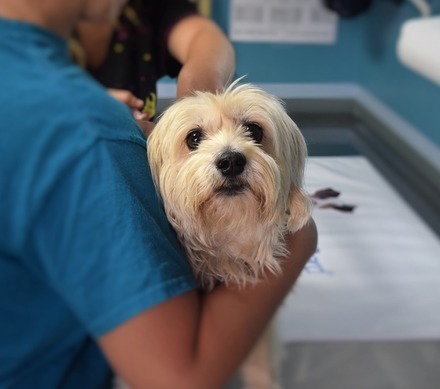Gayle Irwin's Blog, page 22
May 2, 2017
Help with Veterinary Bills
 Just like human medicine, the cost of medical care for our beloved pets can be high. For example, my dog Mary suffers from allergies; her injections cost nearly $300 a year plus she takes daily medication that costs nearly $70 per month. Vaccinations can run $20 to $30 and annual exams nearly $50. Health care for a person’s pet is oftentimes a reason someone will give up that pet (i.e., medication costs) or will ask a vet to euthanize the animal. But, it doesn’t have to be that way. Yet, what is a pet owner, who lives on minimum wage or is working two or more jobs and caring for a family, to do, especially with unplanned, emergency veterinary bills? There are several options.
Just like human medicine, the cost of medical care for our beloved pets can be high. For example, my dog Mary suffers from allergies; her injections cost nearly $300 a year plus she takes daily medication that costs nearly $70 per month. Vaccinations can run $20 to $30 and annual exams nearly $50. Health care for a person’s pet is oftentimes a reason someone will give up that pet (i.e., medication costs) or will ask a vet to euthanize the animal. But, it doesn’t have to be that way. Yet, what is a pet owner, who lives on minimum wage or is working two or more jobs and caring for a family, to do, especially with unplanned, emergency veterinary bills? There are several options.First, explore low-cost vaccination clinics and spay/neuter clinics. Oftentimes various animal welfare organizations will team up with veterinarians to offer such services. For example, my community’s Humane Society pairs with a local vet to offer monthly low-cost vaccination clinics, and occasionally the local city/county animal shelter teams up with a vet to provide low-cost microchip clinics. Learn what’s available in your community for such services.
Second, talk with your veterinarian about a payment plans. Some vets will take monthly or twice-a-month payments; however, many do not. It does not hurt to ask. If your vet is one of those who doesn’t accept payment plans, here are a few other choices for you to consider to help with the financial aspects of your pet’s health care:Pet insurance – there are many companies which offer pet health insurance, helping to pay for basics like vaccinations as well as various health issues and emergency care. Businesses such as Pets Best and Embrace strictly provide pet health insurance, while other companies, such as Nationwide and Progressive have made pet health care part of their insurance offerings. There is a website that rates pet insurance companies and plans; it’s a great place to start if you’re considering purchasing a health care plan for your beloved furry friend: http://www.top10petinsurancereviews.com/.Vetary – this business not only offers a credit-card like program and payment plans, but also helps pet owners get in touch with veterinarians virtually and in their community. The website states, “Vetary is a new type of lender, focused on simplifying and enabling pet care for those who need it most. By building technology solutions that enable instant payments at any veterinary practice, we’ve worked to ensure treatment cost is not a barrier to quality pet care.” You can also find information on a wide range of conditions pets experience, from nose bleeds and tail trauma to cancers and blindness. This information is available for dogs, cats, rabbits, and horses. The company also gives back to local shelters and rescues. Learn more and see if this organization might be of help to you with your vet bills; visit https://www.vetary.com/applicants.Care Credit – this is a product I use, and I’m very grateful to have it. Care Credit is accepted at numerous veterinary clinics, including mine in Casper. It works like a credit card; however, for charges over $200, you have 12 months of interest free to pay off the bill; at least at my vet’s office. I like the convenience and the fact that no interest accumulates; I generally budget so much per month in order to pay off the sum before the 12 months expire. Or, if I have extra money to pay it off more quickly, then I can (and do). I find this set-up works very well for people on strict financial budgets, like me. Care Credit can also be used for human health care, including vision, dental, and some specialty medical care. Learn more at https://www.carecredit.com/procedures/. You can put in your zip code and find out which veterinary and other offices accept Care Credit.
We all want to keep our furry friends as healthy as possible, but sometimes the expense can be challenging. Investigate these options and see if one if right for you. Additionally, here is a website that gives more information on how people can find help to pay their veterinary bills: https://www.paws.org/cats-and-dogs/other-services/help-with-veterinary-bills/.

Published on May 02, 2017 05:00
April 25, 2017
5 Questions to Answer Before Adopting a Pet
 Springtime brings more people outdoors and thoughts about adding a pet to one’s life often occurs during better weather. Playing with a dog in the backyard, taking walks in the neighborhood and beyond, and opening windows to smell fresh air and hear birds sing conjure up ideas about sharing experiences – and life – with a four-footed friend.
Springtime brings more people outdoors and thoughts about adding a pet to one’s life often occurs during better weather. Playing with a dog in the backyard, taking walks in the neighborhood and beyond, and opening windows to smell fresh air and hear birds sing conjure up ideas about sharing experiences – and life – with a four-footed friend.Adopting a pet from a local shelter or rescue is a positive thing; oftentimes, adoption saves lives. The ASPCA (American Society for the Prevention of Cruelty to Animals), which promotes Prevention of Cruelty to Animals Month during April, reports that nearly 6.5 million animals are brought into animal shelters across the nation each year, and about 1.5 are killed in those facilities, oftentimes due to lack of adoption and lack of space. Therefore, adoption does save lives.
However, before running out to your local animal shelter or pet rescue organization, there are five questions a person should honestly answer before bringing a pet home. They are:Am I ready for a pet?
What pet should I get?Where can I find a pet to adopt?Should I get a baby, adult, or senior?Would I be able and willing to care for a pet with a disability?
Let’s take a quick look at each of these questions and hopefully, help you answer them.
Being ready for a pet means examining your lifestyle and family situation. Primarily, do you have enough time to devote to a pet? Is someone responsible enough to not just feed and water the animal, but also to spend quality time playing with and providing activity and companionship for the pet? How many hours do you and your family spend away from home, which would leave the pet alone, possibly bored which, in turn, could lead to destructive behaviors. Make sure you have time to spend with your adopted animal – before you adopt.
What pet best fits your lifestyle? If you are gone a lot, a cat would likely be better than a dog. Cats are often much more independent; not saying you should ignore your cat, but a kitty doesn’t require walking, running, or playing activities as much as a cat does. Still, all pets need friendship and companionship, no matter what type of animal you consider bringing home. Various breeds of dogs need more, or less, activity, so if you’re considering adopting a dog, research the breed’s activity level requirements as well as personality traits. A great place to go for such information is the American Kennel Club’s website:
Finding a place from which to adopt a pet is fairly easy. There are many organizations whose mission it is to help animals in need of new homes. Local animal shelters and humane societies, as well as a wide variety of rescue organizations make saving pets and re-homing them a priority. The best place to start is your local shelter or rescue. Petfinder.com is also a great resource and helps thousands of pets find new homes every year. At this website, you will find specific breeds and ages of animals simply by using the parameters, and your zip code, at the site.
Speaking of ages, does a puppy or kitten suit your lifestyle or is it best for you to adopt an older animal? Baby and teenaged pets often require much more attention, care, and training, whereas adults and seniors are likely to be already trained and able to spend more time alone without worry of soiled carpet or chewed/clawed up furniture. Carefully consider how much time you have with the pet before being swept away by puppy and kitten cuteness.
Another option for adoption is a pet with a disability. These are often the most overlooked, and therefore, most likely to die in shelters. Yet, they are loving, faithful friends when given the chance. Blind, deaf, three-legged, or diabetic, these animals need loving, dedicated homes, too, oftentimes more so than “normal” pets. Consider adopting a pet with a disability, but also carefully consider the pets needs and if you can meet those needs. Deaf animals can – and do – respond to training via hand signals, and blind pets need more safety measures in place. These things are doable, and not costly.
So, are you ready to adopt a pet? Find more information about pet adoption and pet care at https://www.aspca.org/adopt-pet/adoption-tips
http://bestfriends.org/resources.

Published on April 25, 2017 05:00
April 18, 2017
5 Potential Spring Hazards for Pets
 With the warming of the earth, the shining of the sun, and the blueness of the sky, spring brings colorful flowers, green grass, and planted vegetables. This season brings great beauty …. it can also bring hazards for pets.
With the warming of the earth, the shining of the sun, and the blueness of the sky, spring brings colorful flowers, green grass, and planted vegetables. This season brings great beauty …. it can also bring hazards for pets.According to the ASPCA (American Society for the Prevention of Cruelty to Animals), there are many dangers lurking in people’s garages, yards, and gardens, perils that can harm our beloved animals. Here are a few tips to keep your pets safe this season:
Products such as paints and solvents can be toxic to pets, causing severe irritation or chemical burns. Carefully read all labels to see if the products you have on hand are safe to use around your furry friends. Also, be cautious and conscious about things like nails, staples, insulation, saws and blades, and other tools and materials.Products like fertilizers, insecticides, and herbicides which keep plants and lawns healthy and green can be dangerous if a pet ingests them. Store these items out of the way and follow labels carefully.
Many popular spring plants, like rhododendron, azaleas, and lilies, are also highly toxic to pets and can be fatal if eaten. The ASPCA provides a helpful list of plants that can be poisonous to pets. Visit the organization’s website to learn more: https://www.aspca.org/pet-care/animal-poison-control/toxic-and-non-toxic-plants.Spring cleaning the house happens during this time of year; be sure to keep all cleaners and chemicals out of your pets’ reach. Cleaning products can contain chemicals that harm pets. Read and follow label directions for proper use and storage. The ASPCA provides a listing of household products than can be poisonous to pets: https://www.aspca.org/pet-care/animal-poison-control/poisonous-household-products.Like people, pets can be allergic to foods, dust, plants, and pollens. Allergic reactions in dogs and cats causes itching, sneezing, even life-threatening anaphylactic shock to things like insect bites and stings. If you believe your pet has a springtime allergy, visit your veterinarian and consider have your pet tested to learn what causes the allergy. Also, put your pet is on year-round heartworm preventive medication as well as a flea and tick control program. Ask your vet to recommend a treatment to keep these pests at bay.
If you suspect your pet may have ingested something potentially poisonous, contact your local veterinarian or the ASPCA’s Animal Poison Control Center at (888) 426-4435.

Published on April 18, 2017 05:30
April 11, 2017
Lost Pets: The Importance of ID Tags and Microchips
 Last week a friend of mine lost her dog. The black pug escaped out of a backyard gate that hadn’t been latched correctly. Her case is not unusual. Dogs frequently escape. Some dig. Some jump. Some look for those unlatched gates. And some dogs are just prone to wander. For example, the working breeds, from hunters like retrievers to herders like heelers, these types of dogs are bred for different jobs… and they may go looking for that work.
Last week a friend of mine lost her dog. The black pug escaped out of a backyard gate that hadn’t been latched correctly. Her case is not unusual. Dogs frequently escape. Some dig. Some jump. Some look for those unlatched gates. And some dogs are just prone to wander. For example, the working breeds, from hunters like retrievers to herders like heelers, these types of dogs are bred for different jobs… and they may go looking for that work.Cats also are known to roam. Many people don’t like to keep their cat “cooped up,” recognizing a feline’s instinct for hunting. However, whether cat or dog, a loose pet can be a dead pet. Every day, dogs and cats are hit by cars. Sometimes they’re caught in traps. Maybe shot, stolen, or fall prey to predators like owls, hawks, foxes, and coyotes. Therefore, the best idea is keep your pet at home. Cats can easily become indoor pets. Between carpeted towers, windows to look out of, toys that engage their stalking and hunting instincts, and healthy food, a cat will find contentment inside her home.
However, should your pet escape the house or yard, there are ways to increase its chances of returning home. A collar with id tags is very helpful. For those concerned that a collar will hang up on a fence, or for some other reason not a collar on your pet, then please consider a microchip. It's an easy procedure done by your vet; and sometimes shelters offer microchip clinics for reduced fees. iThat way, no matter what happens to the collar (perhaps someone takes it off or the pet slips out of it), you have another way for someone to help your pet get home. Many animal shelters have a microchip scanner and will check stray animals for a chip. Both id tags and microchips need to have up-to-date information – people can’t return your pet if the address and phone number are no longer valid.
To help find your lost pet, here are a few other ideas to consider:Post flyers in your community, especially in the area where your pet was last seen.Knock on neighbor’s doors and tell them about your lost furry friend.Visit your local animal shelter several times; don’t just call and see if you’re pet has shown up and don’t rely on the workers to see the exact color you describe – you know your pet best, therefore, make frequent walk-throughs at the shelter.Post your pet’s picture on a Pets Lost and Found Facebook page if one exists for your community.Run a lost and found ad in your local newspaper.Continue looking and ask family and friends to keep looking – don’t give up! Some animals have been safely returned weeks, even months, after the pet has gone missing.
Before you find yourself in my friend’s situation with a lost pet, take proactive steps, such as collar and id tags, microchip, and regularly checking your gates and fences for closure and holes. Also, be vigilant when opening the doors of your home as well as the gates in your yard. And, if your pet does go missing, do everything you can, employ all types of actions, to get your furry friend back home.
[image error]
Published on April 11, 2017 05:00
April 4, 2017
Volunteers Vital to Helping Animals in Need
 April is known as Volunteer Appreciation Month. Animal welfare organizations, from local shelters and rescues to larger, nation-wide groups depend upon volunteers. In fact, many rescue organizations are strictly volunteer-based. If not for the dedication of volunteers and their love for pets, most companion animal groups would not function well or even exist.
April is known as Volunteer Appreciation Month. Animal welfare organizations, from local shelters and rescues to larger, nation-wide groups depend upon volunteers. In fact, many rescue organizations are strictly volunteer-based. If not for the dedication of volunteers and their love for pets, most companion animal groups would not function well or even exist.Volunteers help pets in need in many ways. Whether walking dogs, brushing and socializing cats, or assisting with transports and fundraisers, volunteers are vital to the health, welfare, and adoption of pets. Most rescue organizations, like Black Dog Animal Rescue in Cheyenne, Wyoming, depend on volunteers to foster animals in their care as these pets await adoptive families. Other groups, like MidAmerica Boston Terrier Rescue and Big Dogs Huge Paws rely upon people to transport dogs either into rescue or to their adoptive families, as oftentimes the distance the animal needs to travel is quite long. This is a role I enjoy fulfilling – transporting a dog into rescue or to its new adoptive family. Several times a year I’m called upon to help transport dogs through my state, usually up or down Interstate 25. Wyoming is a large state and there are great distances between towns; there aren’t a lot of people in the state (at least in the area where I live) who transport. Therefore, whenever I’m available during a time of need, I heed the call. I’ve transported Boston Terriers, Great Danes, English Springer Spaniels, even a Newfoundland for rescue groups in my region. I love every trip, for I know I’m helping a pet in need – it’s an amazing, humbling feeling!
I’ve also traveled to Utah’s Best Friends Animal Sanctuary where I volunteered with the cats. Spending time in their enclosures, playing with them, petting them, as well as taking them outdoors on leashes and in baby buggies, my heart has been filled by knowing I’ve assisted those kitties be more social and therefore, more adoptable. I’m hoping to return to that marvelous place again this year to once again volunteer.
There are many ways a person can volunteer with local, regional, even national animal welfare groups. Some of the endeavors take time, others just a few hours a week, and some just a few hours every few months (like transporting). Here are 10 ways in which you can help animal rescue organizations as a volunteer:Donate time to walk and play with dogs.Donate time to brush and play with cats.Serve as a foster parent, providing a temporary home to injured or orphaned animals, those awaiting a new home, or mothers with very young kittens or puppies.Transport pets going to new homes or into rescue.Assist with fundraising and other special events.Serve as a board member.Serve as a social media coordinator or updating the group’s website.Help landscape and/or clean the facility.Donate products, such as pet food, toys, treats, laundry soap and cat litter.Donate money.
You’ll be amazed at the difference you can make in the lives of pets who need help by volunteering. Take this special time of Volunteer Appreciation Month and consider how you might be helpful to organizations that help pets in need – your service is greatly needed and will be genuinely appreciated!

Published on April 04, 2017 05:30
March 28, 2017
Cruelty Case Reminds Us Abuse is Alive and Well
 The pictures we saw appalled and enraged many. Photos of a dog’s mouth wrapped in electrical tape circulated the internet in 2015. A dog named Diamond was found by her previous owner with physical and emotional injuries, and the abuse led authorities to the dog’s then-owner. Charges were filed and the case was soon to come to court. However, according to a recent article by The Doggington Post, the man, 43-year-old William Leonard Dodson was sentence to 15 years in prison on unrelated charges. He may still receive additional time for the abuse afflicted on Caitlyn, who continues to recover in a foster home. Read the full article here: http://www.dogingtonpost.com/caitlyn-the-dogs-abuser-sentenced-to-15-years-prison-on-unrelated-charges/
The pictures we saw appalled and enraged many. Photos of a dog’s mouth wrapped in electrical tape circulated the internet in 2015. A dog named Diamond was found by her previous owner with physical and emotional injuries, and the abuse led authorities to the dog’s then-owner. Charges were filed and the case was soon to come to court. However, according to a recent article by The Doggington Post, the man, 43-year-old William Leonard Dodson was sentence to 15 years in prison on unrelated charges. He may still receive additional time for the abuse afflicted on Caitlyn, who continues to recover in a foster home. Read the full article here: http://www.dogingtonpost.com/caitlyn-the-dogs-abuser-sentenced-to-15-years-prison-on-unrelated-charges/April is just around the corner, and with it, in addition to the rain showers that can bring May flowers, is the month to bring greater awareness to animal abuse. Known as Prevention of Cruelty to Animals Month, many animal shelters and humane organizations use this month to educate and inform people that animal abuse is, sadly, still alive and well. Many such cases remind us of that sad fact.
For example, the dog fighting operations led by football great Michael Vick made significant headlines and shown a light on this dark, disgusting trade; a small terrier mix, later named Hazel Grace by her rescuers, was burned with a blow torch – the miracle survivor often acts as a poster child for abuse cases in the Midwest; in Utah, family’s beloved pet cat was tortured to death; and in my state of Wyoming, a dog with broken toes and other injuries was rescued by and received veterinary care by a Cheyenne animal welfare organization.
Experts contend that animal abuse often escalates to violence against people, including domestic violence, homicide, and mass murder.
According to the ASPCA, every 60 seconds an animal is abused. What can you do to help fight animal cruelty? Here are a few ways:Don’t buy pets from a pet store. Many animals sold at stores come from puppy mills, which keep dogs, cats, and other companion animals in horrid, unsafe, and unhealthy conditions. Boycott buying – adopt instead.Visit your local animal rescue or shelter to find your next furry friend. Adopt a homeless pet and save two lives: the one you adopt and the one waiting next in line.Volunteer for your local rescue or shelter. Both types of animal welfare group need volunteers, from foster homes and transportation assistants to dog walkers and cat socializers. Help your community continue to help animals in need by volunteering your time.Donate. Help combat animal cruelty, neglect, and abandonment by donating to the rescue organization or purchasing needed supplies, such as pet food and household cleaners.If you see an animal being abused or mistreated, report that incident to local authorities. The only way to truly prevent pain and suffering is to report the cruelty to law enforcement and/or animal welfare.
Read more about helping prevent cruelty to animals by visiting this website: https://www.americanhumane.org/fact-sheet/animal-abuse/
Many people stood up for and continue to stand up for Caitlyn. See the inspiring video at: https://www.youtube.com/watch?v=JTvC1ntqCpI
Be a voice for the voiceless and be a hero to animals like Caitlyn. The more heroes and concerned citizens there are, the more we’ll stop such torture.

Published on March 28, 2017 05:00
March 21, 2017
Welcome Spring, Protect Pets from Potential Poisons
 According to the calendar, spring is here. In my neck of the woods, that appears true, as we've enjoyed temperatures in the high 60s and low 70s the past several days. Daffodils, tulips, and crocus burst forth in early spring, and people are getting the itch to dig in the dirt and plant stuff. Easter’s arrival next month also adds to the scratch. But, if you have pets, there are some flowers and plants a gardener (or potential gardener) should avoid.
According to the calendar, spring is here. In my neck of the woods, that appears true, as we've enjoyed temperatures in the high 60s and low 70s the past several days. Daffodils, tulips, and crocus burst forth in early spring, and people are getting the itch to dig in the dirt and plant stuff. Easter’s arrival next month also adds to the scratch. But, if you have pets, there are some flowers and plants a gardener (or potential gardener) should avoid.This week (March 19 to 25) is Poison Prevention Week. The company ProFlowers has created a helpful guide to plants and their toxicity level. ProFlowers Community Manager Taylor Poppmeier adds to this week’s blog with information and a link to the guide, which can help you determine what you should plant and what you should avoid if you’re a pet owner.
We all want to enjoy spring’s beauty but also protect our furry friends. Therefore, look over this helpful guide and keep your pets safe while also enjoying the colorful beauty of the season.
Did you know that March is Poison Prevention Awareness Month? While March brings warm weather and lots of beautiful flowers, it also means that you should be extra aware of which plants are healthy for your pet to eat and which could be toxic. To help you familiarize yourself with the plants to keep your pets away from, ProFlowers created this visual on 199 poisonous plants. It ranks plants from 1 (majorly toxic) to 4, and notes which parts of the plants are essential to avoid.
Should you suspect your pet has been poisoned, by eating a plant or getting into a household cleaner, contact this hotline number operated by the American Prevention of Cruelty to Animals (ASPCA): 888-426-4435. On the website, you’ll also find a listing of human foods that can negatively impact your pet’s health and a listing of household products which are harmful to animals.
Published on March 21, 2017 05:00
March 14, 2017
Paws to Read: Therapy Animals and Shelter Pets Help Children Improve Reading Skills
 You may have seen news clips or online photos of children reading to animals. Many libraries across the nation have implemented a “Read to the Dog” program, in which children and therapy dogs spend time together at the library, with the children reading to the dogs. But, did you know there are also programs in animal shelters in which children read to the shelter’s residents, cats or dogs? These programs have multiple benefits: helping children improve their reading skills, helping socialize shelter pets, and developing stronger human-animal bonds for both pets and people.
You may have seen news clips or online photos of children reading to animals. Many libraries across the nation have implemented a “Read to the Dog” program, in which children and therapy dogs spend time together at the library, with the children reading to the dogs. But, did you know there are also programs in animal shelters in which children read to the shelter’s residents, cats or dogs? These programs have multiple benefits: helping children improve their reading skills, helping socialize shelter pets, and developing stronger human-animal bonds for both pets and people.The Animal Rescue League of Berks County in Pennsylvania started a Book Buddies program in 2013. Through this endeavor, children in grades 1 through 8 who can read at any level can come to the shelter during regular business hours and read to the cats available for adoption. According to the organization’s website, “the program will help children improve their reading skills while also helping the shelter animals by providing socialization and human interaction. Cats find the rhythmic sound of a voice very comforting and soothing.”
Many literacy experts say children feel more relaxed and less self-conscious reading to animals than reading in front of their peers, to a teacher, or with their parents. Pets and children go together like peanut butter and jelly – mingling and mixing and enjoying one another, all the while improving kids’ reading skills and providing socialization and connection with animals.
In my state of Wyoming, the Sheridan County Library offers a Read-to-the-Dog program several days a week, and north in Montana, the Lewis and Clark Library in Helena also provides such a paw-some service. Children of different ages and reading levels can come and read to a certified therapy dog.
In Salt Lake City, Intermountain Therapy Animals offers a Reading Education Assistance Dogs program, also called R.E.A.D. This program uses already registered therapy dogs and their handlers and trains them to work as a team to improve child literacy. The human-dog teams can go into schools, be at libraries, and visit other settings to serve as reading companions for children.
My dog Mary and I have visited libraries in our area off and on for the past few years. Although we haven’t been part of a Read to the Dog program, we have conducted programs about pet adoption and rescue (my husband and I adopted Mary in 2013 from English Springer Spaniel Rescue), and I have read to children from my various books while Mary sat quietly near my audience and they petted and loved on her. I’m happy to share my sweet Mary with these little ones who hug her, pet her, and talk to her. And her wagging stub of a tail assures me she loves the attention lavished upon and by her!
March is Paws to Read Month, a reminder that children and pets share a special bond, and that implementing a library or shelter program by which children can read to animals either in school, at the library, or at the local animal shelter benefits both kids and pets. If your local library or animal shelter doesn’t have such a program, perhaps you can be the catalyst to help start one. Speak to your shelter’s director or board, speak to your children’s librarian or the library director. Tell them about some of these programs in place around the country. Be an advocate for children’s literacy, therapy animals, and shelter pets, helping benefit kids and animals simultaneously.

Published on March 14, 2017 05:00
March 7, 2017
Dogs and Arthritis: How Can Pet Parents Help Their Aging Pooches?
 My dog Mary turned 11 recently, and during the past few weeks, I’ve noticed a bit of a “hitch in her get-along.” She’s missed the bed at least twice when she’s attempted to jump up on it, and after a night of sleep, she’s appeared a bit stiff. What do dog owners do when their canine companions begin to experience stiffness, soreness, and arthritis?
My dog Mary turned 11 recently, and during the past few weeks, I’ve noticed a bit of a “hitch in her get-along.” She’s missed the bed at least twice when she’s attempted to jump up on it, and after a night of sleep, she’s appeared a bit stiff. What do dog owners do when their canine companions begin to experience stiffness, soreness, and arthritis?I wrote a similar article regarding cats and arthritis last year. Unlike with cats, pet parents can usually tell when their dogs are experiencing trouble with joints. Cats can tolerate a great deal of pain without showing signs; that’s been the case with my two cats, who will be 12 years old in August. However, with my current dog, Mary, and dogs I’ve previously owned that turned 11, 12, or 13 years old, the stiffness and pain they experienced was evident: when they rose from sleeping on a dog bed (or in my bed), when they attempted to jump on furniture and either seemed hesitant or when they missed the mark, and as the temperature went down during winter months.
So, what can we as dog owners do to help our furry friends? There are many products on the market; here’s a short list:
Orthopedic dog beds provide good insulation and support and also make rising easier for dogs.Ramps and steps help dogs get into and out of vehicles and on and off furniture easier.Elevated feeders and waterers provide that added height which can be beneficial.Joint supplements with glucosamine, such as Cosequin can help repair the damaged joint and slow down the progression of arthritis.Anti-inflammatory medications come in both prescription and non-prescription strength.Feeding light foods and treats which help reduce or maintain weight also can alleviate joint discomfort (and remember, you can also make your own dog food and treats – and it may not be as difficult as you think: having chicken or turkey burger yourself for dinner? Then make your dog’s dinner and treats as well at the same time!).
A list of helpful products is available on the Drs. Foster & Smith website:
http://www.drsfostersmith.com/pic/article.cfm?aid=1047
and also at PetCareRX:
https://www.petcarerx.com/article/joint-health-products-for-pets-with-arthritis/707
DogsNaturally provided information on holistic treatment; read that article here:
http://www.dogsnaturallymagazine.com/holistic-treatment-of-arthritis/
Management of arthritis in dogs comes down to three primary things: slowing the progression of the dog's joint condition; improving your dog's comfort; and encouraging your dog to move with moderate activity like walks or swimming. Experts also recommend keeping your dog at a healthy weight, which includes feeding proper food and low-calorie treats as well as providing exercise.
Keeping our senior dogs comfortable and healthy is a significant part of our job as pet guardians. Help your dog age more gracefully and more healthy by alleviating its joint discomfort using some of the tips given – by doing so, you’ll be able to enjoy life together longer and with less pain.

Published on March 07, 2017 05:30
February 28, 2017
Pet-friendly Housing -- Does It Exist?
 One of the reasons people give for leaving their pets at animal shelters or surrendering them to rescue groups is “I’m moving” or “My landlord won’t let me have a pet.” Being separated from one’s animal is heartbreaking, both pet and owner grieve. I’ve volunteered and worked with enough animal rescue and shelter organizations to know how such separation impacts people and animals.
One of the reasons people give for leaving their pets at animal shelters or surrendering them to rescue groups is “I’m moving” or “My landlord won’t let me have a pet.” Being separated from one’s animal is heartbreaking, both pet and owner grieve. I’ve volunteered and worked with enough animal rescue and shelter organizations to know how such separation impacts people and animals.I was recently approached by a fellow pet-lover and writer about contributing to my blog regarding this subject. She’s written a piece about pet-friendly housing, and I agreed to link to her article.
As March dawns and spring draws ever closer, many people consider moving. Therefore, this is a good time to remind those who rent that it’s important to find out as much in advance as possible if the landlord allows pets. If the new place you’re considering is NOT pet-friendly and you have pets, re-consider moving there; search for pet-friendly accommodations. In some areas, you may find buying your own small place a wiser move, both financially and pet-wise. If purchasing your own place is not an option, consider your renting options.
Read this article written by Rebekah May regarding pet-friendly housing and options you may have as a pet parent. The article begins with these thoughts:
Not only is moving a stressful situation, owning pets only serves to compound the hassle. Pet friendly rentals are increasingly harder to come by for pet owners.
Visit this site to read the remainder of her article:
http://www.housinglist.com/hlblog/finding-pet-friendly-rentals/
Published on February 28, 2017 05:00




